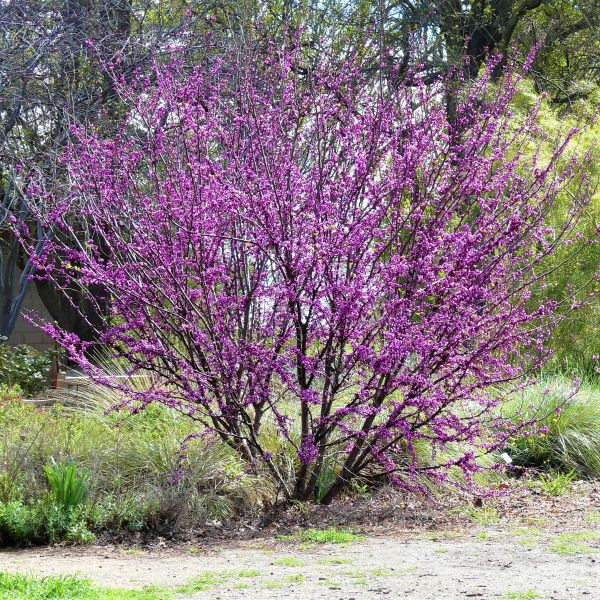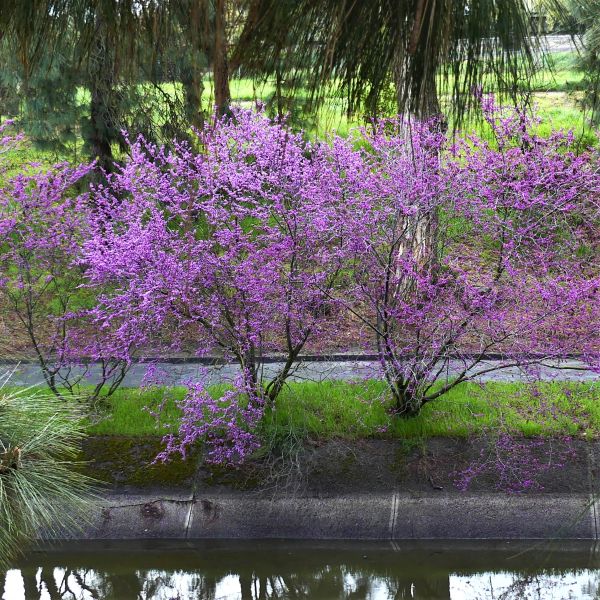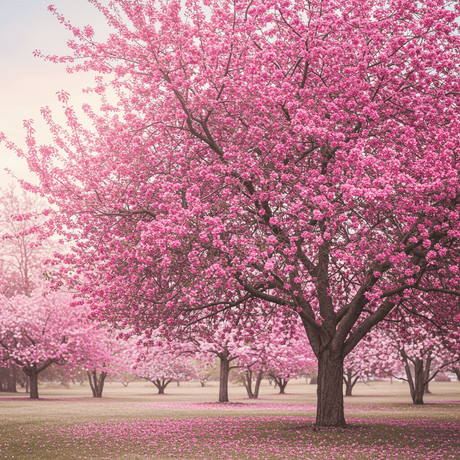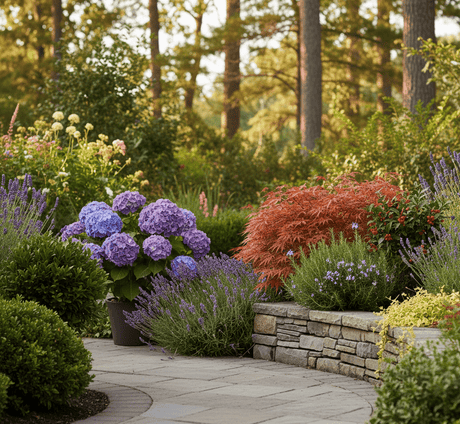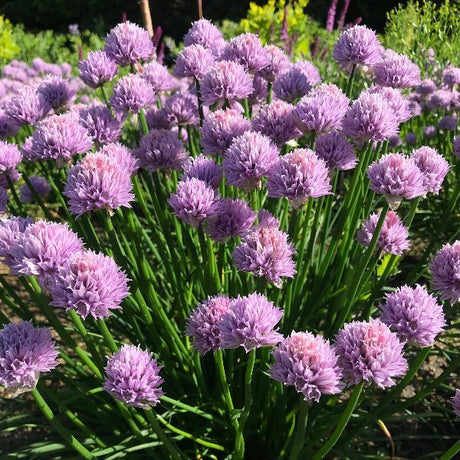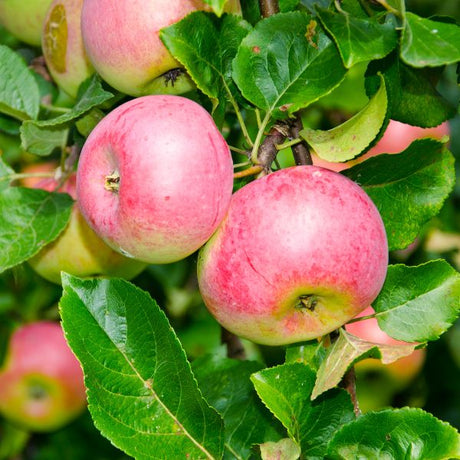Western Redbud Tree
Cercis occidentalis
Plant Sentry™
Plant Sentry™

Plant Sentry™ Protected
Your order is protected by our compliance system that:
- Prevents restricted plants from shipping to your state
- Ensures plants meet your state's agricultural requirements
- Protects gardens from invasive pests and diseases
Delivery and Shipping
Delivery and Shipping
Delivery and Shipping
Fast, Safe Plant Delivery
Ships in 3-4 business days • Tracking provided • Weather protected
| Under $50 | $9.99 |
| $50 - $99.99 | $14.99 |
| $100 - $149.99 | $16.99 |
| $150 - $198.99 | $24.99 |
| $199+ | FREE |
✓ Zone-specific timing • ✓ Professional packaging • ✓ Health guarantee
Understanding Plant Options
Nature Hills offers plants in two main formats:
- Container Plants: Grown in pots with soil, sized by container volume and plant age
- Bare Root Plants: Dormant plants without soil, sized by height measurements
Container Plant Sizes
Container sizes indicate plant age and growing capacity rather than liquid volume equivalents. Our containers follow industry-standard nursery "trade gallon" specifications, which differ from standard liquid gallon measurements.
Young Plants (6 months to 18 months old)
| Container Size | Actual Volume | Metric Equivalent |
|---|---|---|
| 2" x 2" x 3" | 0.18 - 0.21 dry quarts | 0.20 - 0.23 dry liters |
| 4" Container | 0.31 - 0.87 dry quarts | 0.35 - 0.96 dry liters |
| 4.5" Container | 0.65 dry quarts | 0.72 dry liters |
| 6" Container | 1.4 dry quarts | 1.59 dry liters |
| 1 Quart | 1 dry quart | 1.1 dry liters |
| 5.5" Container | 1.89 dry quarts | 2.08 dry liters |
Established Plants (18 months to 2.5 years old)
| Container Size | Actual Volume | Metric Equivalent |
|---|---|---|
| 2 Quart | 2 dry quarts | 2.2 dry liters |
| #1 Container | 2.26 - 3.73 dry quarts | 2.49 - 4.11 dry liters |
| 5" x 5" x 12" | 3.5 - 4.3 dry quarts | 3.85 - 4.74 dry liters |
Mature Plants (2-4 years old)
| Container Size | Actual Volume | Metric Equivalent |
|---|---|---|
| #2 Container | 1.19 - 1.76 dry gallons | 5.24 - 7.75 dry liters |
| #3 Container | 2.15 - 2.76 dry gallons | 8.14 - 12.16 dry liters |
Large Plants (3-5 years old)
| Container Size | Actual Volume | Metric Equivalent |
|---|---|---|
| #5 Container | 2.92 - 4.62 dry gallons | 12.86 - 20.35 dry liters |
| #6 Container | 5.25 - 6.01 dry gallons | 23.12 - 26.42 dry liters |
| #7 Container | 5.98 - 6.53 dry gallons | 26.34 - 28.76 dry liters |
Bare Root Plants
Bare root plants are sold by height from the root system to the top of the plant. Plants may exceed minimum height requirements.
Common Sizes:
- Trees: 1 foot, 2 feet, 3 feet, 4 feet, 5 feet, 6 feet
- Shrubs & Perennials: 1 foot, 18 inches, 2 feet
Important Notes
Container Volume Specifications
- Trade Gallon Standard: Our containers follow industry-standard "trade gallon" specifications established by the American National Standards Institute (ANSI Z60.1) for nursery stock
- Volume Variations: Actual soil volume may vary due to plant root systems and growing medium settlement
- Age Indicators: Container size primarily indicates plant age and maturity rather than liquid volume equivalents
Growing Conditions
- Plant size can vary based on variety and growing conditions
- Container size helps indicate plant maturity and establishment level
- Larger containers generally mean more established root systems and faster landscape establishment
Seasonal Availability
- Bare root plants are available seasonally when dormant
- Container plants are available throughout the growing season
- Specific varieties may have limited availability in certain sizes
Questions?
For questions about specific plant sizes or availability, please contact our plant experts who can help you choose the right size for your landscape needs.

Plant Sentry™ Protected
Your order is protected by our compliance system that:
- Prevents restricted plants from shipping to your state
- Ensures plants meet your state's agricultural requirements
- Protects gardens from invasive pests and diseases
Plant Profile & Growing Essentials
Cold hardy, Native, Flowering, Fall Color/Interest, Attracts pollinators, Drought resistant, and Thornless
Specifications
Specifications
-
Botanical Name
-
Height
-
Width
-
Growing Zones
-
Sunlight
-
Growth RateModerate
-
Flower Color
-
Leaf Color
-
Fall Color
-
NativeYes
-
Pollinator FriendlyYes
-
Bloom PeriodEarly Spring, Late Spring
Planting & Care Instructions
Planting & Care Instructions
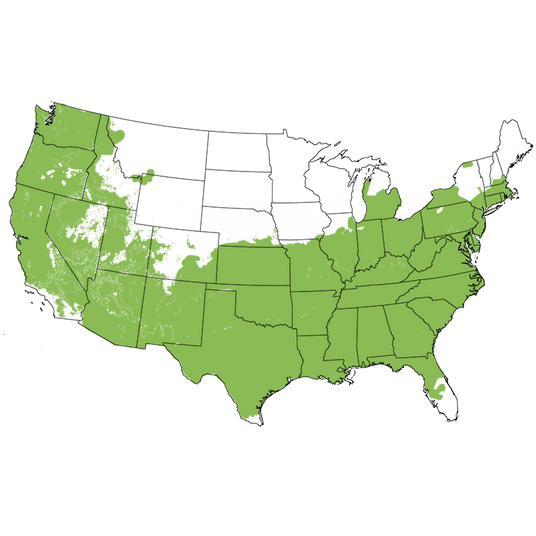
Growing Zones 6-9
There are very few trees that can compare to the seasonal interest of the Western Redbud Tree (Cercis occidentalis). These well-known and highly ornamental small trees are beautiful in each and every season!
In the spring, they begin their show by smothering the naked limbs in rosy lavender-red buds (hence the name!). Since they bloom before most other trees begin to leaf out - even before they leaf out themselves - they are stunningly eye-catching in the early spring garden! Early-emerging pollinators seeking an early feast will find plenty of nectar with these pea-like blossoms!
In the summer, the buds are gone and are replaced with romantic heart-shaped leaves that start out apple-green and turn a lovely shade of blue-green as they age. Long seed pods emerge and ripen to a rich purple-brown and feed your birds.
In the fall, the leaves turn shades of gold and bring a true "autumn" feel to the landscape. Then the smooth silver-gray bark and zig-zagging stems make the branches shine against the winter landscape of gray and snowy days.
Landscape Application:
These small trees will fit into just about any garden. They also fit into just about any garden style, too. We've seen them look like watercolor paintings in Japanese-inspired and Zen gardens and like fireworks in contemporary settings!
They are classic cottage garden border trees since they don't take over and shade the border too much and change with the perennial plantings every season. They also can look rustic or eclectic, depending on the setting. Western Redbuds are truly versatile!
Grown as either a single-stem, multi-stemmed, or shrub-form tree depending on your preferences! Try growing yours as a specimen for curb appeal or as screening, property division, and privacy groupings!
It is the perfect little shade or accent tree, used almost anywhere in the landscape. One would look lovely in a formal setting by your patio or walkway. Or, create a feature out of a larger planting. Use 3, 5, or 7 trees in a woodland setting, easily naturalizing, and rambling throughout the canopy of larger trees, not minding a touch of afternoon shade. This natural understory tree will lend an incredible wilderness effect.
- Vibrant Pink Blossoms
- Apple-Green Heart-Shaped Foliage
- Versatile Small Flowering Tree
- Four-Seasons of Interest
- Western American Native Selection
#ProPlantTips for Care:
Plant your Redbud in full sun in cooler climates, but you can grow yours in some partial/afternoon shade in the hottest growing zones. It is adapted to many soil types, including clay or sandy, and is not sensitive to soil pH. Provide regular moisture access for new trees, but Western Redbud becomes drought tolerant once established.
Keep the root system cool in hot, dry climates with a 3 to 4-inch layer of shredded wood mulch, spread out 3 feet past the canopy. This tree will tolerate a considerable amount of heat once established. Trim after the flowers fade to correct growth and control size.
- Best in Full Sun or Partial Shade
- Well-Drained Soils
- Moderate Moisture Needs
- Prune After Flowering
- Deer Seldom Bother These Trees
The Western Redbud Tree is very easy-care and will reward you with beauty all year for minimal effort on your part. Don't wait! Order yours today at NatureHills.com!
Single Stem, Multi Stem, Shrub Form, Oh My!
Before you buy, make sure you know what you’re getting! Single-stem, multi-stem, and shrub forms are different so read a bit about which we’re currently offering below.
Single Stem:
These are plants that have one stem coming from the ground. Plants can also be considered single-stem when lower branches are removed to raise the height of the branching. Sometimes, you will hear a single stem referred to as Tree Form.
Multi Stem:
These are plants with 2 or more stems planted together in the ground in close proximity to form a clump. There are times when multiple stems are formed by a tree that branches at the soil line with more than one main stem.
Shrub Form:
These are bushy plants with many stems and branches close to the ground. They are referred to as shrubs or bushes and are often shorter than their tree forms.

